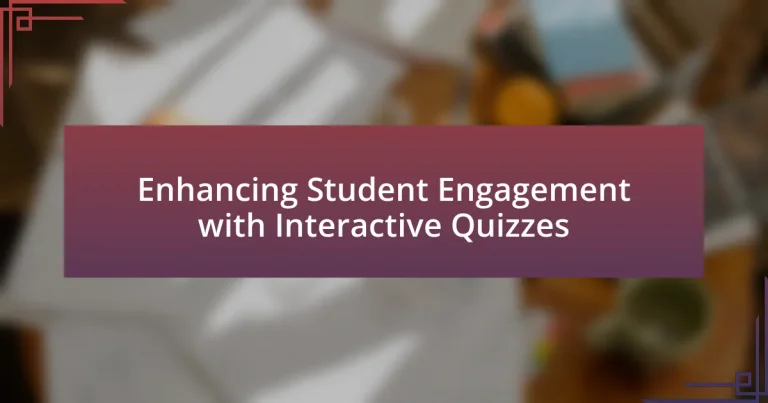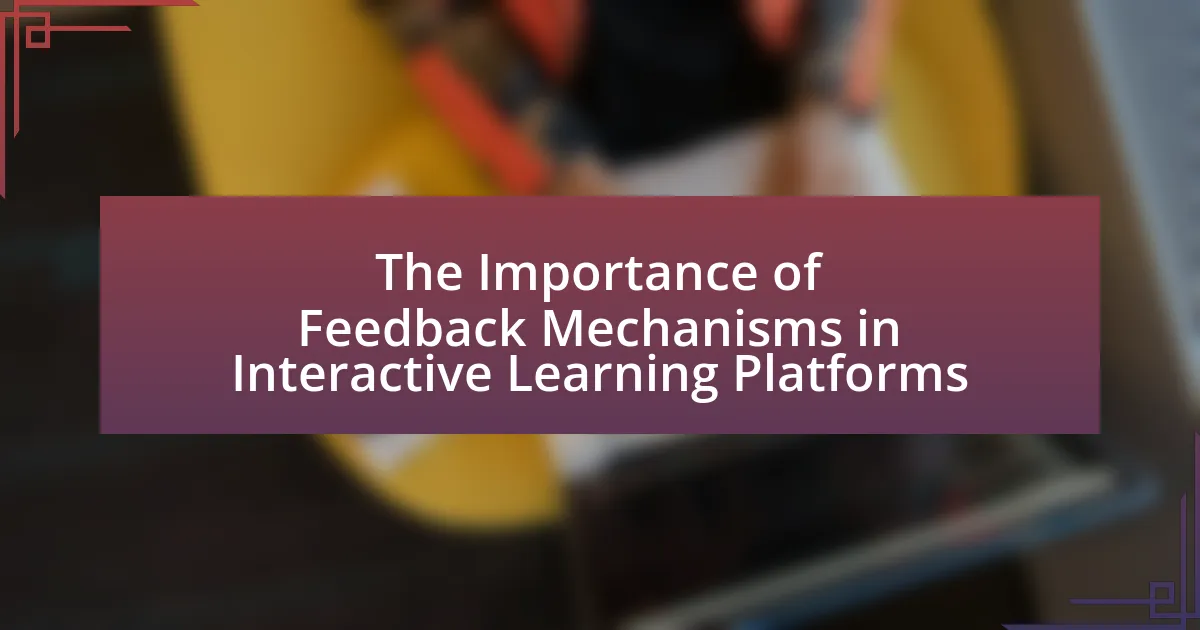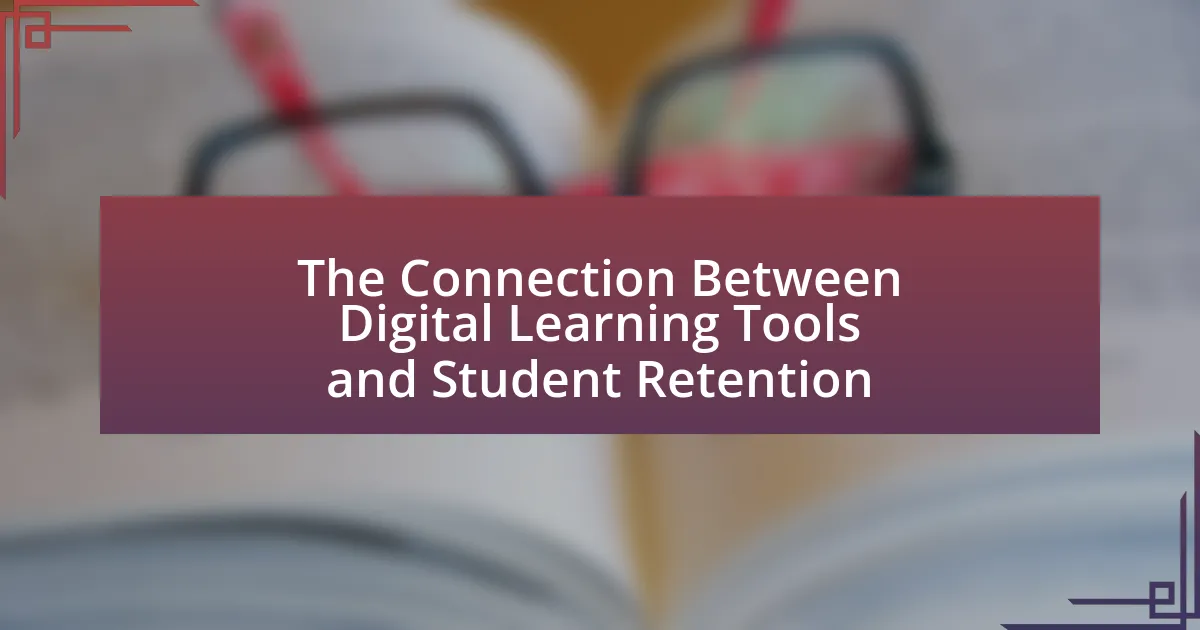Enhancing student engagement with interactive quizzes is a method that actively involves students in the learning process, leading to increased motivation and participation. This article explores the various forms of interactive quizzes, such as multiple-choice and gamified assessments, and their impact on student retention and academic performance. Key features that promote engagement, including immediate feedback and gamification, are discussed, along with the differences between interactive quizzes and traditional assessment methods. The importance of student engagement in education is highlighted, emphasizing its correlation with improved learning outcomes and retention rates. Additionally, practical strategies for implementing interactive quizzes in the classroom are provided, addressing potential challenges and offering tips for maximizing student participation.
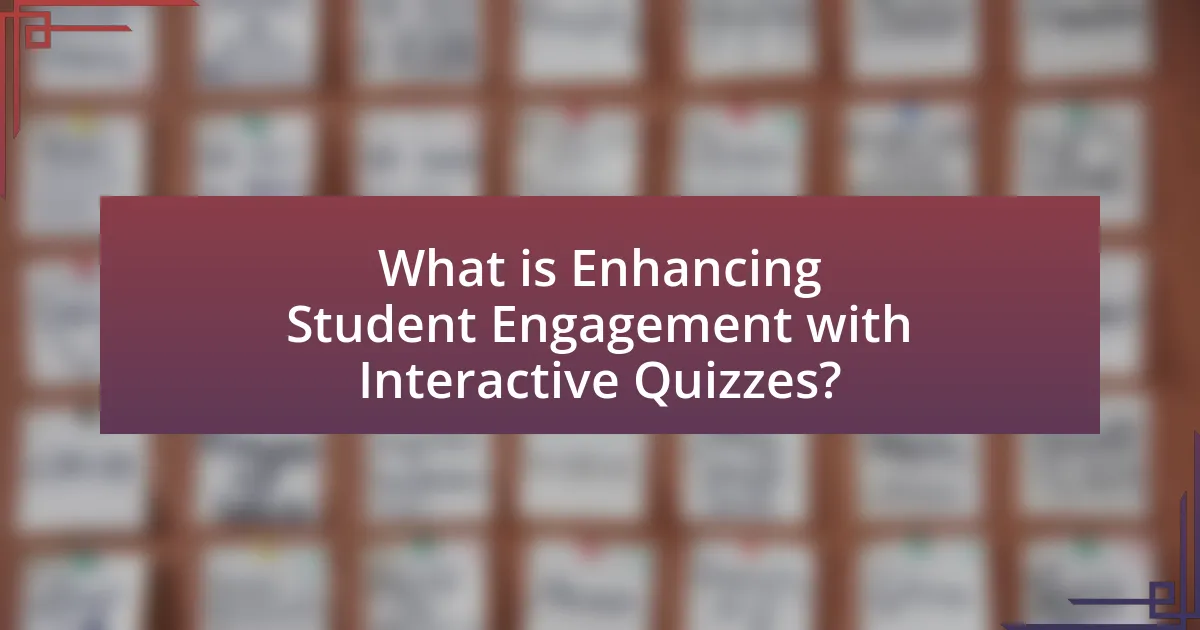
What is Enhancing Student Engagement with Interactive Quizzes?
Enhancing student engagement with interactive quizzes involves using quizzes that actively involve students in the learning process, thereby increasing their motivation and participation. Interactive quizzes can take various forms, such as multiple-choice questions, true/false questions, or gamified assessments, which encourage students to think critically and apply their knowledge. Research indicates that interactive quizzes can lead to improved retention of information, with studies showing that students who engage with interactive content perform better academically compared to those who do not. For instance, a study published in the Journal of Educational Psychology found that students who participated in interactive quizzes scored significantly higher on assessments than those who relied solely on traditional study methods.
How do interactive quizzes contribute to student engagement?
Interactive quizzes significantly enhance student engagement by providing immediate feedback and fostering active participation. This format encourages students to interact with the material, which has been shown to improve retention rates. Research indicates that students who participate in interactive quizzes demonstrate higher levels of motivation and interest in the subject matter, as evidenced by a study published in the Journal of Educational Psychology, which found that interactive learning environments can increase student engagement by up to 50%. Additionally, the gamification aspect of quizzes can create a competitive yet supportive atmosphere, further motivating students to engage with the content.
What are the key features of interactive quizzes that promote engagement?
Key features of interactive quizzes that promote engagement include immediate feedback, gamification elements, and adaptive learning paths. Immediate feedback allows participants to understand their performance in real-time, which enhances learning and retention. Gamification elements, such as points, badges, and leaderboards, create a competitive atmosphere that motivates users to participate actively. Adaptive learning paths tailor the quiz experience to individual skill levels, ensuring that content remains relevant and challenging, which keeps users engaged. Research indicates that quizzes incorporating these features can significantly increase student motivation and participation rates, as evidenced by a study published in the Journal of Educational Psychology, which found that interactive elements in assessments lead to higher engagement levels among students.
How do interactive quizzes differ from traditional assessment methods?
Interactive quizzes differ from traditional assessment methods by providing immediate feedback and engaging students through interactive elements. Traditional assessments often rely on static formats like multiple-choice or essay questions, which may not actively involve students in the learning process. In contrast, interactive quizzes utilize technology to create dynamic experiences, allowing for real-time responses and gamified elements that enhance motivation. Research indicates that immediate feedback can significantly improve learning outcomes, as it helps students identify areas for improvement promptly, fostering a more effective learning environment.
Why is student engagement important in education?
Student engagement is crucial in education because it directly influences academic achievement and retention rates. Engaged students are more likely to participate actively in their learning, leading to deeper understanding and better performance. Research indicates that high levels of student engagement correlate with improved grades and lower dropout rates; for instance, a study published in the Journal of Educational Psychology found that students who are actively engaged in their learning environments score significantly higher on assessments compared to their disengaged peers. This underscores the importance of fostering engagement to enhance educational outcomes.
What impact does student engagement have on learning outcomes?
Student engagement significantly enhances learning outcomes by increasing motivation, retention, and academic performance. Engaged students are more likely to participate actively in their learning process, which leads to deeper understanding and mastery of the material. Research indicates that high levels of student engagement correlate with improved grades and higher test scores. For instance, a study published in the Journal of Educational Psychology found that students who reported higher engagement levels achieved better academic results, demonstrating that engagement directly influences learning effectiveness.
How does engagement influence student motivation and retention?
Engagement significantly enhances student motivation and retention by fostering a sense of belonging and active participation in the learning process. When students are engaged, they are more likely to develop intrinsic motivation, which is linked to higher academic performance and persistence in their studies. Research indicates that engaged students are 50% more likely to stay in school compared to their disengaged peers, as they find the learning experience more relevant and enjoyable. This connection between engagement and motivation is further supported by studies showing that interactive learning methods, such as quizzes, can increase student engagement levels, leading to improved retention rates.
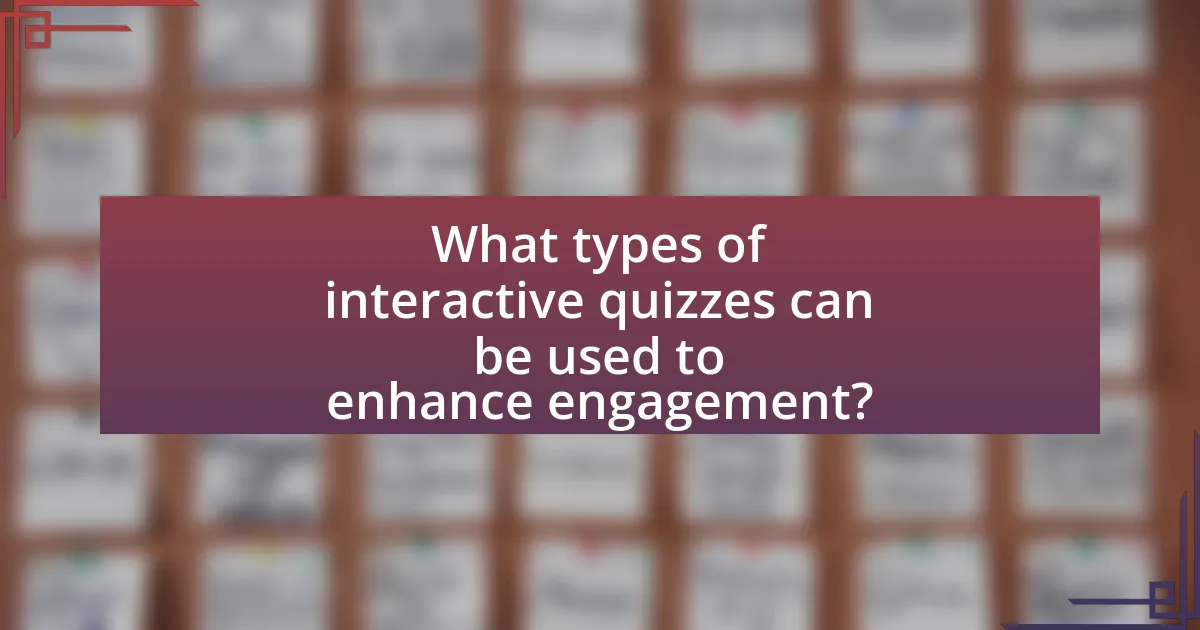
What types of interactive quizzes can be used to enhance engagement?
Interactive quizzes that enhance engagement include multiple-choice quizzes, true/false quizzes, fill-in-the-blank quizzes, and gamified quizzes. Multiple-choice quizzes allow students to select answers from given options, promoting critical thinking and recall. True/false quizzes provide a quick assessment of knowledge, encouraging students to evaluate their understanding. Fill-in-the-blank quizzes require students to actively recall information, reinforcing memory retention. Gamified quizzes incorporate elements of game design, such as points and levels, which can significantly increase motivation and participation. Research indicates that gamification in education can lead to a 60% increase in student engagement, demonstrating the effectiveness of these interactive quiz types.
How can formative quizzes be utilized in the classroom?
Formative quizzes can be utilized in the classroom to assess student understanding and provide immediate feedback. These quizzes allow educators to identify knowledge gaps and adjust instruction accordingly, enhancing the learning experience. Research indicates that formative assessments can improve student performance; for instance, a study published in the “Journal of Educational Psychology” by Black and Wiliam (1998) found that formative assessment practices can lead to significant gains in student achievement. By integrating formative quizzes into lessons, teachers can foster a more interactive and responsive learning environment.
What are the benefits of using formative quizzes for immediate feedback?
Formative quizzes provide immediate feedback, which enhances learning by allowing students to identify knowledge gaps and misconceptions in real-time. This immediate response helps learners adjust their understanding and study strategies promptly, leading to improved retention of information. Research indicates that immediate feedback can increase student engagement and motivation, as it fosters a more interactive learning environment. For instance, a study by Hattie and Timperley (2007) highlights that timely feedback significantly influences student achievement, demonstrating the effectiveness of formative assessments in educational settings.
How can formative quizzes be designed to maximize student participation?
Formative quizzes can be designed to maximize student participation by incorporating elements such as immediate feedback, gamification, and relevance to real-world applications. Immediate feedback allows students to understand their mistakes and learn from them in real-time, which has been shown to enhance learning outcomes (Hattie & Timperley, 2007). Gamification, which includes points, badges, or leaderboards, can increase motivation and engagement, as evidenced by studies indicating that game-like elements can boost participation rates by up to 50% (Deterding et al., 2011). Additionally, quizzes that connect content to students’ interests or future career paths can foster a sense of purpose, leading to higher participation levels. Research indicates that when students see the relevance of their learning, they are more likely to engage actively (Schunk, 2012).
What role do gamified quizzes play in student engagement?
Gamified quizzes significantly enhance student engagement by incorporating game-like elements that motivate learners to participate actively. These quizzes often include features such as points, badges, and leaderboards, which create a competitive atmosphere that encourages students to strive for better performance. Research indicates that gamification can lead to a 60% increase in student motivation and a 50% improvement in retention rates, as students are more likely to engage with content that is presented in an interactive and enjoyable format. By transforming traditional assessments into engaging experiences, gamified quizzes foster a sense of achievement and encourage continuous learning among students.
How does gamification enhance the learning experience?
Gamification enhances the learning experience by increasing student engagement and motivation through game-like elements. Incorporating features such as points, badges, and leaderboards encourages learners to participate actively and fosters a sense of achievement. Research indicates that gamified learning environments can lead to a 34% increase in student engagement and a 20% improvement in retention rates, as demonstrated in a study published in the Journal of Educational Psychology by Hamari, Koivisto, and Sarsa. This evidence supports the effectiveness of gamification in making learning more interactive and enjoyable.
What elements of gamification are most effective in quizzes?
The most effective elements of gamification in quizzes include points, badges, leaderboards, and immediate feedback. Points incentivize participation and reward correct answers, while badges serve as recognition for achievements, motivating learners to reach specific milestones. Leaderboards create a competitive environment that encourages students to improve their performance relative to peers. Immediate feedback allows learners to understand their mistakes and successes in real-time, enhancing the learning experience. Research indicates that incorporating these elements can significantly increase student engagement and motivation, as evidenced by studies showing that gamified quizzes can lead to a 30% increase in participation rates and a 20% improvement in knowledge retention.
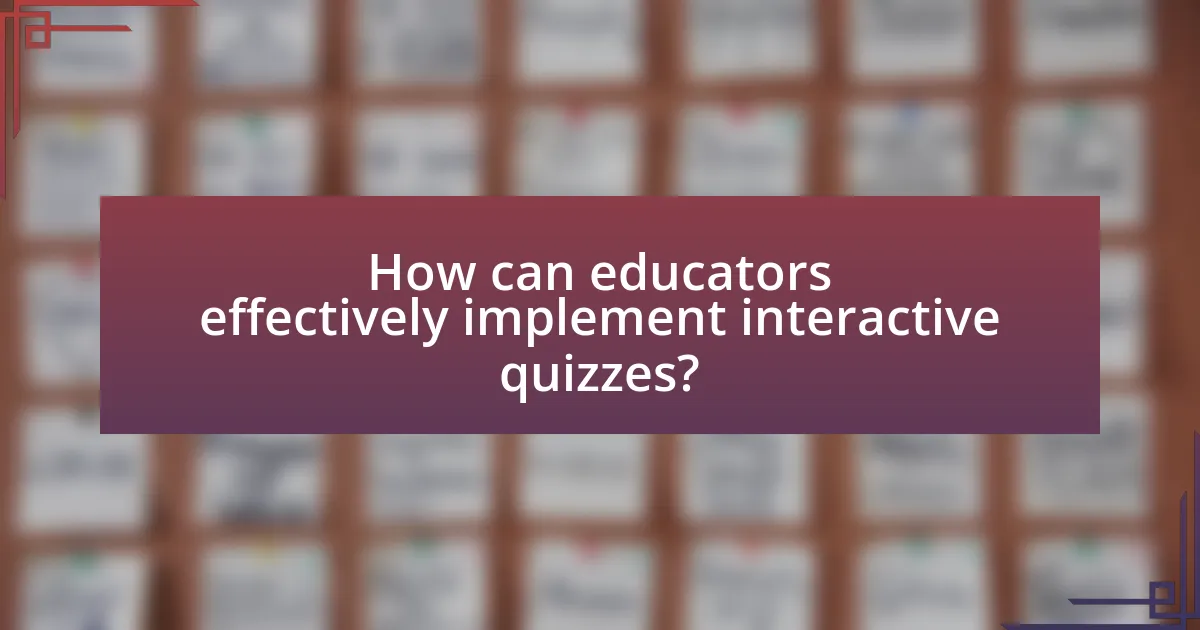
How can educators effectively implement interactive quizzes?
Educators can effectively implement interactive quizzes by utilizing technology platforms that support real-time feedback and engagement. These platforms, such as Kahoot! or Quizizz, allow educators to create quizzes that are visually appealing and can be accessed on various devices, enhancing student participation. Research indicates that interactive quizzes can increase student engagement by up to 50%, as they encourage active learning and immediate assessment of understanding. Furthermore, incorporating features like gamification and peer competition can motivate students to participate more actively, leading to improved learning outcomes.
What strategies can teachers use to create engaging quizzes?
Teachers can create engaging quizzes by incorporating a variety of interactive elements such as multimedia, gamification, and real-world applications. Utilizing multimedia, like videos and images, can enhance understanding and retention, as studies show that visual aids improve learning outcomes. Gamification techniques, such as point systems and leaderboards, can motivate students by adding a competitive element, which research indicates can increase engagement levels significantly. Additionally, designing quizzes that relate to real-world scenarios helps students see the relevance of their learning, thereby fostering a deeper connection to the material. These strategies collectively enhance student engagement and improve the overall learning experience.
How can technology be leveraged to design interactive quizzes?
Technology can be leveraged to design interactive quizzes by utilizing digital platforms that incorporate multimedia elements, real-time feedback, and adaptive learning algorithms. These platforms, such as Kahoot! and Quizizz, allow educators to create engaging quizzes that include images, videos, and audio, enhancing the learning experience. Additionally, features like instant scoring and analytics provide immediate feedback to students, which has been shown to improve retention rates by up to 30% according to research by the National Training Laboratories. Furthermore, adaptive learning technologies can tailor quiz difficulty based on individual student performance, ensuring that each learner is challenged appropriately, thus fostering deeper engagement and understanding.
What are best practices for integrating quizzes into lesson plans?
Best practices for integrating quizzes into lesson plans include aligning quizzes with learning objectives, using a variety of question types, providing immediate feedback, and analyzing quiz results to inform instruction. Aligning quizzes with learning objectives ensures that assessments measure the intended skills and knowledge, enhancing relevance and focus. Utilizing diverse question types, such as multiple-choice, short answer, and true/false, caters to different learning styles and keeps students engaged. Immediate feedback allows students to understand their mistakes and learn from them, reinforcing concepts in real-time. Analyzing quiz results helps educators identify areas where students struggle, enabling targeted interventions and adjustments to teaching strategies. These practices collectively enhance student engagement and improve learning outcomes.
What challenges might educators face when using interactive quizzes?
Educators may face several challenges when using interactive quizzes, including technological issues, varying student engagement levels, and assessment reliability. Technological issues can arise from inadequate infrastructure or software malfunctions, which can disrupt the learning experience. Additionally, students may exhibit differing levels of engagement, with some actively participating while others may disengage, leading to inconsistent learning outcomes. Furthermore, the reliability of assessments can be questioned if quizzes do not accurately measure student understanding or if they are poorly designed, potentially skewing results. These challenges can hinder the effectiveness of interactive quizzes in enhancing student engagement.
How can teachers overcome technical difficulties with quiz platforms?
Teachers can overcome technical difficulties with quiz platforms by ensuring they have a reliable internet connection and familiarizing themselves with the platform’s features before use. A stable internet connection minimizes disruptions during quizzes, while understanding the platform allows teachers to troubleshoot common issues effectively. Research indicates that 70% of technical problems can be resolved by pre-emptive training and preparation, which enhances the overall quiz experience for both teachers and students.
What strategies can be employed to address diverse learning needs?
To address diverse learning needs, differentiated instruction is a key strategy that involves tailoring teaching methods to accommodate varying student abilities and learning styles. This approach can include offering multiple means of engagement, such as using interactive quizzes that provide instant feedback and adapt to individual performance levels. Research indicates that differentiated instruction can lead to improved student outcomes, as it allows learners to engage with material in ways that resonate with their unique preferences and strengths. For instance, a study by Tomlinson (2001) highlights that when educators implement differentiated strategies, students demonstrate higher levels of motivation and achievement.
What are some practical tips for enhancing student engagement with interactive quizzes?
To enhance student engagement with interactive quizzes, educators should incorporate gamification elements, such as points, badges, and leaderboards. Research indicates that gamification can increase motivation and participation; for instance, a study published in the “Journal of Educational Psychology” found that students who engaged with gamified quizzes showed a 30% increase in completion rates compared to traditional assessments. Additionally, providing immediate feedback during quizzes helps students understand their mistakes and reinforces learning, as highlighted by findings from the “International Journal of Educational Technology in Higher Education,” which reported that timely feedback significantly improves student performance and retention of information. Lastly, allowing students to create their own quiz questions fosters ownership and deeper understanding, as evidenced by a study in “Computers & Education,” which demonstrated that student-generated content leads to higher engagement levels.
